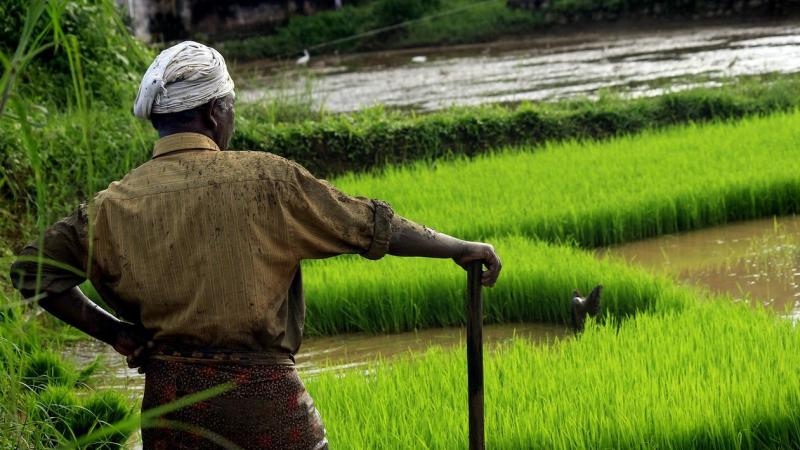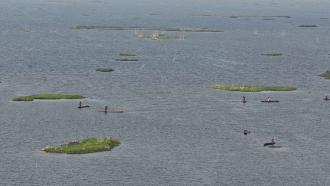
Oryza sativa, or rice, is the staple food of more than half the world’s population and supports the livelihoods of around 145 million households. Since its domestication thousands of years ago, rice has played an essential role in shaping civilisations. However, present-day practices of rice cultivation may harm the planet's climate, shows a recent study conducted in India. Published in the journal Proceedings of the National Academy of Sciences (PNAS) of the United States of America, the study assesses if intermittent flooding in rice fields, a common practice in India, could be contributing to large emissions of two greenhouse gases, methane and nitrous oxide.
“Evidence suggests that rice has been grown for at least 10,000 years. At first, rice was grown in forest clearings under a system of shifting cultivation. The crop was direct-seeded, without standing water and fertilisers—conditions only slightly different from those to which wild rice was subject”, says Dr Kritee, a researcher at the Environmental Defense Fund, New York, and the lead author of the paper. The absence of standing water and fertilizers leads to negligible production of methane and nitrous oxide, respectively.
Over the years, the practice of rice cultivation changed in order to increase production. “Puddling the soil, turning it to mud and transplanting seedlings became integral parts of rice farming giving a head start to higher yields”, says Dr Kritee. In this PNAS study, the researchers assessed the climate impact of different intermittent flooding and fertiliser use regimes in rice farms for three years. They defined three kinds of intermittent flooding patterns: mild-intermittent flooding where there is a near-constant and shallow flooding of soil, medium-intermittent flooding where the water levels fluctuate at an intermediate level, and intense intermittent flooding where the water levels fluctuate most intensely and reach much below the root zone of the rice plant many times during a season.
The researchers hypothesized that by managing the quantity of nitrogen, water and organic matter added to land, the net climate impacts of rice cultivation could be reduced. By simultaneously changing these variables in farmer-managed plots, the researchers compared the greenhouse gas emissions between conventional farms: farms that make use of chemical fertilizers, and those with climate-smart practices: farms that use high organic matter, low quantities of chemical fertilizers and mild intermittent flooding. They also made an attempt to understand the causes of variations in the emission rates of nitrous oxide with respect to methane under varied soil and farm management parameters.
The study showed that nitrous oxide levels were 30-45 times higher under medium or intense forms of intermittent flooding as compared to those typically found under continuous flooding. Also, the flooding pattern was found to be the most important predictor of nitrous oxide emissions from rice farms indicating that more intense the intermittent flooding, higher the nitrous oxide emissions. Overall, the findings of the study show that by co-managing the use of fertilisers and organic matter along with a mild form of intermittent flooding (that avoids both, standing water and intense forms of intermittent flooding), can minimize both methane and nitrous oxide emissions from rice farms in India by an average of 60 percent.
The study also used a mathematical framework, called Technology Warming Potential framework, to compare the collective climate impacts of various greenhouse gases and the different technologies used in rice cultivation. “Such a framework is important to consider because a single flooding pattern can lead to the production of more than one greenhouse gas. In our use of this framework, we assumed that for a period of 200 years, both nitrous oxide and methane are emitted continuously and indefinitely at different rates under different flooding regimes. Then we compared the cumulative climate impact of each flooding pattern”, explains Dr Kritee.
Lastly, the PNAS study showed geospatial risk analysis, for the entire Indian subcontinent (including Pakistan, Nepal, Sri Lanka and Bangalore), that clarifies which geographic areas might hold the highest risk of large nitrous oxide emissions. As expected, the risk analysis indicated that rice farms that were rainfed and irrigated with multiple wet and dry cycles were at risk for high emissions of nitrous oxide. On the other hand, rice irrigated with continuous flooding, and those in wetlands were less susceptible to such emissions. Authors have provided a similar geospatial analysis for the entire world and other detailed discussions here.
Studies like this are crucial given that the current estimates of global methane emissions from rice farms are at 36 Million Metric Tons, and these methane emissions from rice are expected to double by 2100. The current mitigation policies support the use of intermittent flooding as a means to reduce methane emissions from rice farms. However, they have mostly ignored the possibility of high rates of nitrous oxide emissions and increase in net climate impact of rice farming due to intermittent flooding. This PNAS study highlights the fundamental ways in which the pathways to reduce methane emissions can increase nitrous oxide emissions.
The authors suggest that more research that provides rigorous data from medium- and intense-intermittently flooded rice farms from multiple geographies around the world is necessary. “It is absolutely possible to advance rice farming practices through governmental and corporate policies that achieve triple win—i.e., maximise yields, farm-level profits and minimise environmental impacts. Triple win, however, requires that at a minimum the global community immediately start mapping water levels across farmer-managed rice fields across the world. This will help design the best climate mitigation strategies for different rice growing countries”, says Richie Ahuja, a co-author of the study.






